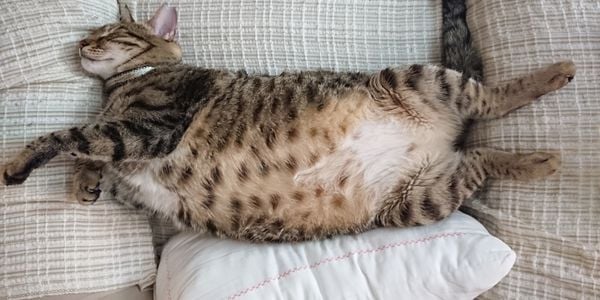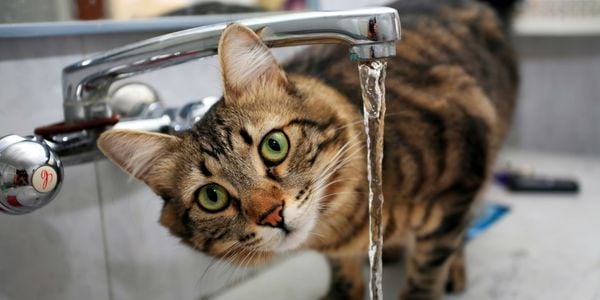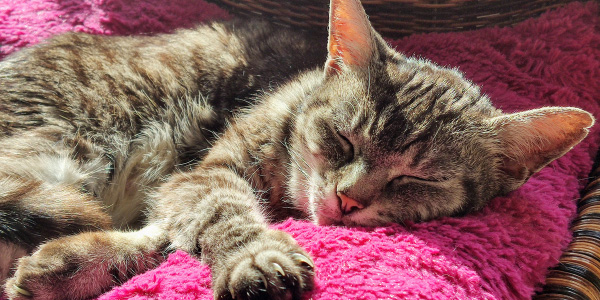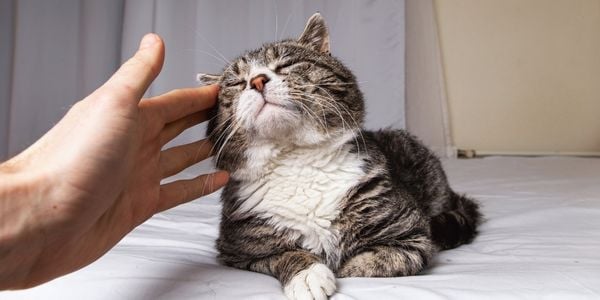 I thought before we get into the nitty gritty about diabetes that it would be interesting to share an itty-bitty bit of history with you.
I thought before we get into the nitty gritty about diabetes that it would be interesting to share an itty-bitty bit of history with you.
Now, if history isn’t your thing, then feel free to skip ahead (my feelings won’t be hurt!).
The first use of the term “diabetes” was used by Apollonius of Memphis around 250 to 300 BC.
The "sweet" nature of urine that resulted from the condition is what gave the disease its name Diabetes Mellitus. Diabetes is from the Greek word diabetes, which means siphon (to pass through). Mellitus is the Latin word for sweet.
Prior to the development of chemical tests (which didn’t happen until the 1800s) to detect the presence of sugar in the urine, diabetes was diagnosed by “water tasters.” These individuals would taste the urine of individuals suspected of having diabetes. Fortunately for human doctors and veterinarians, diagnostic testing has come a long way since then!
It took until 1922 before the effective treatment, insulin, was available.
Despite all the research and discoveries, as well as the development of management strategies, this condition remains a common chronic disease that affects people and pets.
SNAPSHOT: What You Should Know About Diabetes in Cats
- Diabetes is often easily diagnosed and controlled; however, when undiagnosed or poorly managed, diabetes can be devastating.
- Diabetes can absolutely be managed, and your cat can still lead a long and happy life. But it does require your commitment and dedication since it requires lifelong treatment.
- Routine veterinary care and evaluation are important, as is achieving and maintaining an appropriate weight in your cat and feeding them an appropriate diet.
- Since diabetic cats need to maintain an ideal weight to better regulate their blood glucose and proper hydration is critical for diabetics, especially those with other underlying medical issues, feeding canned food only or a mix of canned and kibble is most beneficial to your cat’s well-being.
Skip to section:
What is Diabetes Mellitus?
In the most basic terms, diabetes mellitus is a disorder where blood sugar, or glucose, cannot be effectively utilized and regulated by the body.
Several hormones within the body play important roles in glucose metabolism. Insulin is one of the most important, if not the most important. It’s the hormone most central to both the worsening and control of the diabetic state. Glucose fuels the body, and insulin is the hormone that helps get it into most cells within the body.
When there is a lack of insulin, or the body can’t respond to it properly, glucose becomes dangerously high in the bloodstream (hyperglycemia), which then leads it to pass through into the urine (glucosuria).
Type I Diabetes in Cats
There are two types of diabetes. In Type I diabetes, also known as insulin–dependent diabetes, the pancreas does not produce or release enough insulin within the body due to the destruction of its beta cells (insulin-producing cells). While cats can have Type I, Type II is more common.
Note: Type I diabetes is the usual form that dogs get. Only rarely are dogs Type II.
Type I diabetes is treated with insulin (injections) and a diet change. Weight control is also another important factor in management.
Oral therapies are not applicable to Type I diabetes.
Type II Diabetes in Cats
In Type II diabetes (also known as non-insulin dependent diabetes), while there may be enough insulin available in the body, the cells of the body don’t respond well to it.
Type II diabetes is treated with insulin injections, diet change, and weight management.
Note: Diabetic remission is possible in a third to half of diabetic cats that receive early intensive management. Some studies indicate that the number can be as high as 80%.
At the end of 2022, the FDA approved the first oral treatment for cats with diabetes. The drug is called Bexacat. Careful screening prior to use and close monitoring following the start of the medication is critical. The oral treatment cannot be used if:
- Cat has been previously treated with insulin
- Cat is receiving insulin currently
- Cat had Type I diabetes
The end result in both types of diabetes is a defect in glucose metabolism within the body and all the negative health implications that it can cause.
Fortunately, armed with some good information, important tips, and a good working relationship with your veterinarian, you can give your cat the best chance at managing this frustrating condition — avoiding the potential complications and perhaps even getting them into diabetic remission.
Learn how to prevent diabetes in your cat.

Causes and Risk Factors of Diabetes in Cats
Almost exclusively, cats suffer from the Type II form of the disease. During their lifetime, between 0.2 % and 1% of cats will be diagnosed with diabetes. What’s even sadder is that this incident rate seems to be on the increase.
Several risk factors have been identified for the development of diabetes. They include:
Obesity
It is four times more likely for an obese cat to develop diabetes mellitus than an ideal-weight cat.
Fat produces the hormones adiponectin, resistin, and leptin. The regulation of glucose is affected by these hormones. There is a 30% reduction in the sensitivity to insulin for every extra kilogram of body weight. And excess body fat can also cause higher than normal blood glucose levels.
Note: A cat is considered obese if they are 3 pounds over their ideal weight.
Increasing age
Diabetes is more likely diagnosed in cats between 6 to 8 years of age, but cats of any age can be affected.
Gender
This disease is more common in male cats than female cats.
Diet and exercise
Cats that exclusively eat a high carbohydrate diet (which includes pretty much any dry cat food diet) are at higher risk. So are cats who are sedentary, as they are more likely to be overweight.
Genetics and breed
Burmese cats seem to be at a higher overall risk.
Certain drugs and medications
Megestrol, acetate, progestins, and corticosteroids have been found to predispose cats to the development of diabetes when used chronically or long-term.
Other diseases
Pancreatitis results in the inflammation of the cells of the pancreas, which secrete insulin. In some cases, this is temporary; in others, these cells stop functioning permanently.
Additionally, pancreatitis can create inflammation in the body that lessens the ability of target tissues to increase glucose uptake in response to insulin, and generally, other inflammatory issues are also present at the same time.
Endocrinopathies, such as hypersomatotropism (acromegaly) and hyperadrencortism (Cushing’s disease), can develop into diabetes mellitus and are often very difficult to regulate.

Early Signs and Symptoms of Diabetes in Cats
Although the actual diagnosis of diabetes requires a thorough physical exam and laboratory testing of both blood and urine by your veterinarian, there are certain early signs that you might notice at home that could indicate the presence of a problem.
None of the signs and symptoms listed below are specific only to diabetes. They could indicate one of several common disorders. So regardless, if you notice these signs, don’t hesitate to take your cat to the vet for evaluation – ideally sooner rather than later.
Excessive urination (polyuria)
Excessive urination is a result of the glucose passing through the kidneys into the urine. The glucose hinders the kidneys from being able to retain water normally, as well as pulling excess water into the urine. The result is increased urine production and increased urinary water loss.
Often the first indication that a cat is urinating excessively is that there are more and larger clumps of urine in the litter box or your cat is having urine accidents outside the litter box. It is important that cats with excessive urination be seen by a veterinarian to determine the underlying cause.
Note: When cats urinate outside of their litter box on a hard surface due to diabetes, you will notice the urine is more sticky and crystalized as compared to normal urine.
Excessive thirst (polydipsia)
Many owners report their cat drinking from the dog’s water bowl, sink, bathtub, or toilet. This increased thirst in cats is driven by their bodies to prevent and treat dehydration due to the increase in urine production and water loss.
Besides diabetes, there are other causes of increased thirst in cats.
Factors that increase a cat’s thirst include:
- A change in the weather and/or humidity
- A change in your cat’s activity level
- A change in your cat’s food
- Progressive kidney disease
- An overactive thyroid gland (Hyperthyroidism)
- Certain liver disorders
- Cushing disease (rare)
- Diabetes insipidus (rare)
- Amongst other conditions
As you can see, even just from this partial list, there are many possibilities, other than diabetes, for your cat's excessive thirst.
How do you know if your cat is excessively thirsty?
Typically, cats need between 3.5–4.5 ounces (about ½ a cup) of water per 5 pounds of body weight per day. If you have a 10-pound cat, they should be consuming between 7–9 ounces (about 1 cup) of water.
If your cat is persistently drinking more than 0.8 ounces per lb (50mls per kg) of body weight per day (24-hour period), it could be excessive and mean that a veterinary evaluation is necessary. Anything persistently over 1.5 ounces/lb/day (100mls/kg/day) is definitely excessive and in need of veterinary evaluation.
Increased appetite (polyphagia) – often accompanied by weight loss
Glucose provides the body with energy. In the case of diabetes, your cat’s body is unable to use the blood glucose for energy because of the lack of insulin or insulin resistance. In order for the body to compensate for this, it uses fat and protein stores. As the body continues to break down fat and protein, there is weight loss due to the loss of fat and muscle.
When not addressed early, the continued breakdown of fat for fuel by the liver can lead to a potentially life-threatening condition called ketoacidosis (explained below).
Many diabetic cats have a ravenous appetite, often pestering their owners for more food after clearing out their bowls. Many owners may not immediately realize, especially if their cat has long fur, that despite their cat’s limitless appetite, they are actually losing weight.
This is very dangerous regardless of the cause, so if you notice this sign, have your cat evaluated by your veterinarian sooner rather than later.

Generally speaking, the likelihood of the signs mentioned above indicating diabetes in your cat is increased if your cat is overweight/obese and eating predominantly or exclusively a dry food diet.
Such cats are often referred to as ‘pre-diabetic.’ These cats are just waiting for an excuse – illness, medication, or stress – to push them over the edge into full-blown diabetes.
Questions? To chat with a veterinarian about your cat and diabetes, Click here
Later Signs and Symptoms of Diabetes in Cats
When the early signs of diabetes are not detected, or adequate glycemic control is not achieved, and blood glucose levels remain elevated for months, you will observe these later signs.
Walking flat on the back of their hind legs
Veterinarians refer to this as a ‘plantigrade stance’ or ‘dropped in the hocks.’ This is the result of damage and dysfunction to the nerves that feed into the back legs.
This is typically obvious when you view your cat from the side. Normally in cats, the point at the back of the cat’s hind leg is off the ground when they walk. In cats with a plantigrade stance, they walk with it very close to or in contact with the ground.
Here is a video example of a cat dropped in the hocks when walking.
Lost interest in or no longer able to jump
This can sometimes be a very subtle sign, but those in tune with their cat’s activity level may notice their cats lying low more often.
Vomiting, lethargy, and lack of appetite
These are very late signs of diabetes. When these signs occur, a cat's health is in the most jeopardy.

Complications of Under-Managed Diabetes
Diabetes is often easily diagnosed and is controllable. However, when undiagnosed or poorly managed, a cat’s lifespan will be shortened.
Diabetes can be devastating and lead to a variety of debilitating, expensive, and potentially fatal conditions. Some of the more common conditions are outlined below.
Diabetic ketoacidosis (DKA)
Diabetic ketoacidosis is a common and dangerous complication that results from the diabetic animal’s body having to rely too long on burning fats for energy rather than the glucose that the cells require.
The product that results from the breakdown of fat is ketones. This alternative fuel in low levels can be helpful, such as in starvation (or intermittent fasting for humans). But the body can only do this for so long.
When the levels of ketones become excessively high, they make the blood too acidic, and these changes are so severe they prevent normal body function.
Certain underlying medical conditions can increase the likelihood of your cat developing ketoacidosis. These include:
- Infections, such as urinary tract infections
- Kidney failure
- Pancreatitis
- Liver issues (like fatty liver disease)
- Certain cancers
The signs that indicate your cat may have developed ketoacidosis include those mentioned as part of early and late symptoms of diabetes as well as:
- Fast breathing
- Severe dehydration
- Coma
- Death
DKA is a dire metabolic pet emergency, and treatment is best achieved at a 24-hour animal ER with true intensive care (ICU) capabilities and around-the-clock care.
Hypoglycemia
A relatively common emergency complication of diabetes in cats (as well as in people and dogs). Hypoglycemia literally means ‘low blood sugar.’
If your cat’s blood sugar drops below a certain level, you may notice the following:
- Weakness
- Lethargy
- Shaking
- Unsteadiness
- Seizures
If not managed appropriately, seizures can lead to permanent brain damage, coma, and death. Hypoglycemia in diabetic animals typically results from one of two situations.
- The first is when the diabetic cat receives a double insulin dose – often one from each caregiver.
- The second common scenario is when the diabetic cat receives the correct dose of insulin, but other factors, such as the pet not eating their normal meal or another change in diet, create an imbalance.
The potential for hypoglycemia is the reason why every owner of a diabetic pet should have a bottle of Karo syrup (also maple syrup, honey, gel icing, or corn syrup) on hand.
Rubbing any of these on the gums of a pet that is seizing because of hypoglycemia can help to halt the seizures while on the way to the veterinarian.
Note: Never attempt to get your cat to swallow any substances (food, liquid, or paste) while seizing or comatose in order to raise their blood sugar. Only rub the syrup on their gums.
Urinary tract infections
Because diabetic pets have glucose in their urine, they are at an increased risk of bacterial infections within their urinary tract. These infections can be difficult to get rid of and are likely to reoccur.
This can create a vicious cycle, as infections anywhere in the body can make diabetes regulation more difficult, leading to more glucose in the urine and a greater risk for infection.
If such infections affect the kidneys too, then acute (sudden) kidney failure and long-term kidney damage can result.
Be sure to have your diabetic cat’s urine checked for infections regularly with your veterinarian, as diabetic pets aren’t always “clinical” (i.e., showing signs of) their urinary tract infections.
Hypertension
Cats with diabetes are at an increased risk of developing high blood pressure (hypertension – systolic blood pressure > 180mm Hg). This can lead to organ damage, including your cat’s brain, kidneys, and eyes. Have your veterinarian check your cat’s blood pressure regularly.
Hind limb weakness
Diabetes, when not properly managed, can lead to damage of the nerves of the hind limbs. When this occurs, cats appear to be walking or standing on their hocks. It is referred to as a ‘plantigrade’ stance.
This condition is not painful, and proper treatment of diabetes typically results in the improvement of this issue. See this video of a diabetic cat walking on their hocks.
Diabetic Neuropathy
For diabetic cats, diabetic neuropathy is one of the most common chronic complications. It can range from very mild to severe.
The exact cause is unknown, but the constant stay of the body being in hyperglycemia cause axonal degeneration (causes a loss of communication between neurons) and demyelination (degeneration of the sheath around the nerves). The pelvic limbs are usually more affected than the thoracic limbs. See the video below for what this looks like.
When cats are treated and properly managed, the condition can resolve, but it can take six to twelve months.
Signs and symptoms include:
- Weakness of the hind limbs
- Decreased ability to jump
- Plantigrade posture
- Muscle loss (atrophy)
Increased susceptibility to infection
Diabetes lowers a cat’s ability to fight infection because it weakens their immune system. Dysfunction of the immune system, likely caused by hyperglycemia, prevents it from being able to control and prevent the spread of pathogens.
Slows wound healing
When the immune system isn’t functioning normally due to elevated blood glucose levels, slow healing of wounds is an unfortunate side effect.
High blood glucose levels can cause a disruption in the micro-environment of the arteries, which results in them becoming stiffened and narrow. When this occurs, there is a reduction in blood flow. A reduction in blood flow to the cells decreases their oxygen and nutrient levels. Without proper oxygen levels and nutrients, the cells responsible for wound healing can’t function properly. The end result is slow or non-healing wounds.
Increased susceptibility to other health issues
An overall poor immune system makes diabetic cats more susceptible to the development of other health issues and diseases.
Joint issues
Diabetes causes inflammation within the entire body. One of the largest driving factors for the development of arthritis is inflammation. Arthritis affects the entire joint (the joint capsule, muscles, ligaments, tendons, etc.).
The resulting discomfort and pain can hinder your cat's mobility, increasing the likelihood of pressure sores and potential infections (i.e., urinary tract infections from not wanting to use the litter box due to pain or infection from urine scold what is "scald" – skin infection caused by urine or fecal matter remaining on the fur and skin – from poor grooming).
A complicating factor to the arthritis caused by diabetes is the muscle weakness that occurs in the hind limbs due to low blood potassium (hypokalemia).
Cataracts
The cause of diabetic cataracts is due to the conversion of glucose to sorbitol by the enzyme aldose reductase. Since diabetic cats have low levels of this enzyme, unlike people and dogs, cataract formation in cats due to diabetes is rare.
Hyperglycemic Hyperosmolar Nonketotic (HHNK) Syndrome
An uncommon complication of undiagnosed or unregulated diabetes, HHNK occurs when your cat’s blood sugar rises so high that urine is produced at a higher rate than the cat can drink water. This leads to a severe imbalance within the blood and other tissues of the body.
Symptoms of HHNK include:
- Progressive weakness
- Complete lack of appetite (anorexia)
- Lethargy
- Drinking less
- Extreme depression
- Coma
As in the case with DKA, treatment for HHNK should happen with the involvement of a board-certified or residency-trained veterinary criticalist or internist at a 24-hour veterinary ER.
Questions? To chat with a veterinarian about your cat and diabetes, Click here.

What You Can Do at Home to Help Your Cat With Diabetes
After your cat has been diagnosed with diabetes, you and your veterinarian need to closely monitor them. By working in conjunction with your veterinarian while following their treatment plan for your cat, you will better manage your cat’s diabetes and avoid complications.
Weight management
Help your cat achieve and maintain an appropriate weight. Read our article on how much to feed your cat.
Note: As part of your treatment monitoring process, be sure to weigh your cat weekly and record it in your logbook, so trends can be tracked. This will alert you to changes in their usual pattern and help you know sooner than later to consult with your veterinarian. You can use a pet scale or step on your own scale with your cat in your arms and deduct your weight.
Keep track in a logbook
Keep a logbook at home to note changes in your cat’s appetite, thirst, eliminations, and energy level. This will help your veterinarian in assessing your cat. In the long run, this will save you time and money (less travel and money spent on veterinary visits).
Click Here to Download Our Free Feline Diabetes Meal and Insulin Tracking Log
Use the book to also record:
- Insulin injections – the amount given and the time given
Note: Be sure there are no air bubbles in the syringe before injecting. If you see some, tap the syringe to make the bubbles go to the top. Then push them out with the plunger. Be sure that you still have the correct number of units prior to injection.
Note: Alternate the location each time you give an injection. This helps prevent soreness and scar tissue build-up. - The amount and time that food was fed and eaten
- Their ‘urine dip’ (using urine test strips) Note: Do not use the results of urine test strips to guide insulin doses. They are essentially valuable in helping you monitor the amount of glucose in the urine and to determine the need for further evaluation by your veterinarian. Sometimes insulin amounts need to be adjusted, but this must be done under the supervision of your vet. See how to collect a urine strip sample below.
- Blood glucose monitoring results (using a monitor device)
Collect urine 'dip' data
This information is to be tracked into your logbook.
To test the urine, you will need to plan ahead because you will need a clean litter box with no litter or fecal matter (meaning a fresh urine sample). I would suggest keeping a litter box just for sampling. Remove the ‘regular’ litter box and place the urine collection box in its place.
Some cats won’t pee in an empty box, so you can place some non-dissolving packing peanuts or try this urine collection kit. Once your cat pees, dip the stick into the urine and then follow the directions on the package for the test strip. Once done, record the result and clean the ‘pee box’ for next time.
Since testing isn't perfect via this method, I would suggest testing when you notice a change in the frequency of urination and/or your cat is drinking more.
Your cat's food
Your veterinarian will discuss what diets are best for your cat, over-the-counter canned food or a prescription diabetic diet for cats.
If your veterinarian recommends a change in diet, be sure to do so gradually over about a week or two. DO NOT suddenly switch diets, as this could cause gastrointestinal issues that may complicate your cat’s diabetes.
Once a diet has been established, you must keep your cat’s diet consistent, including food type, quantity of food, and timing of meals. This can help to ensure that their insulin requirements aren’t changing on a regular basis and can help with regulation.
Supplements
Probiotics can benefit your cat.
Keeping up with your diabetic cat’s oral hygiene is important. In addition to brushing their teeth, use VetriScience Perio Powder on their food. Not only will it help with their teeth, it can encourage them to eat when they aren’t in the mood.
Providing your cat with omega-3 fatty acids (in fish oil) will help manage inflammation and reduce pain, and it has been found to lower blood lipid levels.
Proper management of insulin and needles
- Communicate well with the other caretakers in your home to ensure that the correct insulin dose is administered when it is due and that you do not double-dose your cat. Consider keeping a calendar near the fridge where the insulin is stored to mark off when injections are given.
- Appropriately store, handle, and rotate out (once opened, insulin vials must be discarded after 30 days) your cat’s insulin. Obtain refills one to two weeks in advance to ensure that you always have your cat’s insulin on hand.
- Ensure that you always pair the correct size and type of insulin syringe for the type of insulin you are using (U-40 vs. U-100). Not doing so can lead to underdosing or overdosing. Neither is desirable, and overdosing can prove fatal. Your veterinarian will advise you on the needle type, and if you are getting your cat’s insulin from a human pharmacy, be sure they give you the correct syringe type.
Be prepared for emergencies
- Have Karo or corn syrup on hand (also maple syrup, honey, or gel icing).
Rubbing any of these on the gums of a pet that is seizing because of hypoglycemia can help to halt the seizures while on the way to the veterinarian.Note: Never attempt to get your cat to swallow any substances (food, liquid, or paste) while seizing or comatose in order to raise their blood sugar. Only rub the syrup on their gums.
If you have a pet first-aid kit, you can add this specific glucose gel to your kit or velcro it to the inside of a kitchen cabinet door. And don't forget to pack it if you travel with your cat. There are cooler bags that work really well for keeping all the insulin and syringes in one easy-to-find place. Insert a note into the bag of units of insulin and how many times per day, just in case of an accident. Having a collar on your cat that says "diabetic"on it is very helpful as well.
- Be sure that any pet sitter that you leave in charge of your diabetic cat’s care when you leave town is well-versed in the management and complications of diabetes.
You should download our Treatment Authorization form, sign it, and give it to your cat sitter. It provides them with the ability to help your cat while you're out of town and not reachable should a medical issue arise.
What You Can Do With Your Veterinarian
- Maintain a close working relationship with your veterinarian and their support staff. Be honest about your capabilities (both practical and financial). Stick with the recommended in-clinic monitoring plan discussed with your veterinarian.
- Ask the veterinary staff to show you how to monitor your cat’s ‘urine dips’ and/or blood sugars at home.
- Ask the veterinarian or veterinary nurse to show you how to give injections.
- Work with your veterinarian to ensure that your cat doesn’t have any underlying medical conditions or infections that can predispose your cat to diabetes or complicate its management.
- Share what medications and supplements your cat is on with your vet to ensure that none of them predispose your cat to diabetes or make its management more difficult.
- In difficult-to-control cases, speak with your veterinarian about a referral to a board-certified veterinary internal medicine specialist. You can also locate these specialists by searching the American College of Veterinary Internal Medicine database.
Routine veterinary care and evaluation are important, but equally as important is achieving and maintaining an appropriate weight in your cat.

Preventing Diabetes in Cats
While there are some factors that cause diabetes that cannot be prevented (such as a breed predisposition), there are many steps you can take to prevent diabetes in your cat. They include the following:
Help your cat achieve and maintain an ideal body condition. This is more than just their weight, but also their muscle mass and body fat. Ask your veterinarian to help you assess your pet’s body condition. You can get a sense of it by looking at this chart.
Feed your kittens and cats a diet that more closely matches what their system has evolved to handle – this typically means a higher protein and lower carb canned diet. Long-term feeding of a high carbohydrate and protein-depleted diet increases your cat’s risk for obesity and diabetes (and isn’t good for their kidneys and urinary tract health either).
Dry food (a.k.a. kibble) may have fewer benefits to cats than canned food, especially for those with predispositions to certain medical conditions.
Cats are obligate carnivores and are not ‘designed’ to thrive on dietary carbohydrates. Additionally, in the wild, they are used to obtaining most of their moisture from what they eat. Kibble contains more carbohydrates than canned food.
Cats that tend to be sedentary and prone to weight gain are more likely to become obese and develop diabetes than those fed only canned food or a mix of canned and kibble.
Cats don’t drink enough water to compensate for the loss of water from the diet when they are fed dry food only. This can potentially be a significant issue for cats predisposed to urinary tract disease or kidney disease.
Since diabetic cats need to maintain an ideal weight to better regulate their blood glucose and proper hydration is critical for diabetics, especially those with other underlying medical issues, feeding canned food only or a mix of canned and kibble is most beneficial to your cat’s well-being.
Provide your cat with playtime and sources of environmental enrichment to decrease their stress and keep their weight down. Here are a few articles to get you started:
- What to do if your cat is bored
- Make playtime fun using the prey sequence
- Different cat toys and how to use them to satisfy your cat's needs
Regardless of your cat’s vaccine schedule, take them to your veterinarian for annual examinations and evaluations. A thorough physical examination can uncover the first, sometimes very subtle, signs of disease. Additionally, this is often the only time your cat gets weighed, and trends in their weight gain (or loss) can be an indicator of an underlying problem.
Annual, and sometimes even twice-annual, veterinary examinations are key in the prevention of many pet diseases and emergencies. It can actually save you money in the long run, too, as many diseases are less expensive to manage and regulate when they are caught early.
Ask your veterinarian to perform regular routine blood and urine screening tests. Both blood AND urine are necessary to diagnose diabetes. Even if the results of such tests are normal, it will be money well spent.
You will rule out diabetes as well as a host of other disorders. You will be establishing your cat’s specific normal baseline results, which will be invaluable in the event of future problems.
Note: Cats can have stressed-induced hyperglycemia (300 mg/dl to 400 mg/dl) – meaning they could be misdiagnosed with diabetes or not diagnosed if it's chalked up to stress, as glucose can be elevated in a stressed cat.
If you want to be certain, a fructosamine test can be performed. Fructosamine is not affected by stress, and its measurement helps determine the average blood glucose level for the prior two to three weeks. You can request this test if you're concerned about a potential misdiagnosis.
Be careful with the use of steroids (especially the long-acting or depo-medrol injection preparations) in obese cats when treating other chronic conditions. Steroids are commonly used in the management of feline asthma (also known as feline allergic bronchitis), inflammatory bowel disease, and chronic skin allergies. Glucocorticoids (steroids) decrease the effectiveness of insulin in your cat’s body, creating an insulin-resistant state and diabetes.
Especially if your cat is overweight, thoroughly discuss the use and potential side effects of such medications with your veterinarian before their administration. When used appropriately and in the right circumstances, glucocorticoids can be life-saving and life-improving medications, but it is important to note that they are not without their risk for side effects.
My life…..
I wish to share something very personal with you, and I do so not for sympathy but to help you understand that while diabetes seems scary, with commitment and dedication, you can make it work.
Diabetes is the one condition I never wanted my pets or anyone I love to have. From the moment I learned about in vet school, it terrified me. I hated every time I diagnosed a patient with it because I knew that to be successful and for the patient to do well, it would require a lot of time, commitment, and dedication.
On my son’s 10th birthday, he was diagnosed with Type I diabetes. When I received the news in the doctor’s office, I sobbed. I felt so bad for the poor doctor, and my son had no idea what life would be like from there on out.
We spent that night in the children’s ICU since my son had ketoacidosis. We then spent the next several months being educated and working closely with his medical providers.
Our lives, especially his, are forever changed. But by being educated and knowing what steps to take – he is thriving. And the same can happen for you and your cat.





